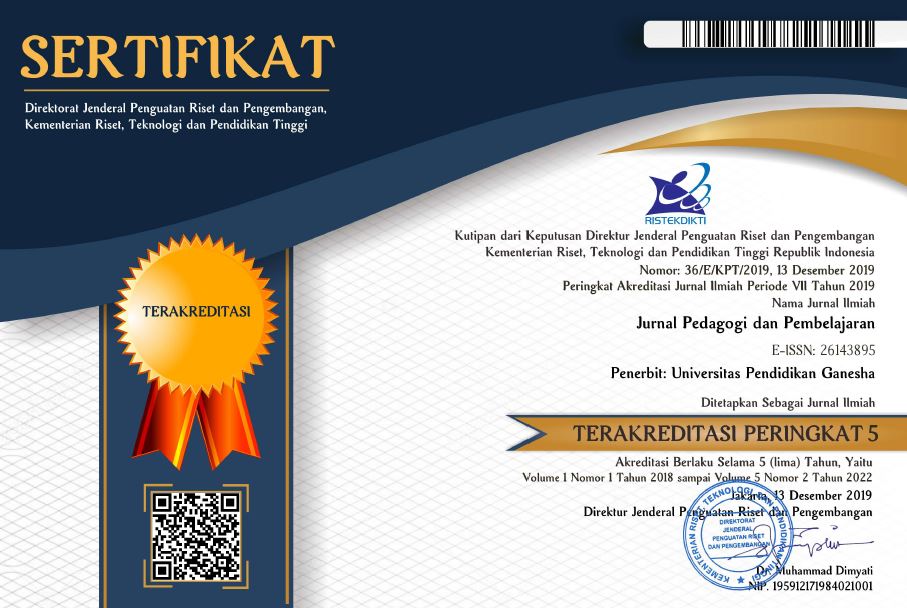Worksheets and Joyful Teaching Strategies in Teaching English to Students of English Village of Parit Baru
DOI:
https://doi.org/10.23887/jp2.v6i1.53820Keywords:
English Village, Worksheets, Joyful Teaching StrategiesAbstract
English lessons are not compulsory in public elementary schools. It makes English a challenge for students in Indonesia's foreign language communication from an early age. This study aimed to find student worksheets and fun learning strategies, including singing and mentoring activities, to be implemented in teaching English to students. This research includes case study research. This study used a sampling technique to select five fifth-grade students who participated in this program. Data collection was carried out using participant observation techniques, and the documents included were student worksheets, photos, and activity videos. Data analysis techniques using thematic analysis techniques. The study results show that student worksheets and fun learning strategies can help students in English Village learn English through all teaching stages. It was concluded that alternative learning in the form of English Village using student worksheets and fun learning strategies had been proven to help students learn English by providing brief material that is clear and easy to understand.
References
Agustina, P. (2019). Hubungan antara minat warga belajar dengan persepsi diri tentang kemampuan berbahasa Inggris di Camp Mahesa putri Kampung Inggris Pare Kediri. Jurnal Mahasiswa Pendidikan Luar Sekolah, 8(2).
Anrasiyana, A., Sulistyaningsih, S., & Syakur, A. (2022). Creating Vlog as Media in English Language Teaching (ELT): Teaching Speaking. Journal Basicedu, 6(2). https://doi.org/10.31004/basicedu.v6i2.2575. DOI: https://doi.org/10.31004/basicedu.v6i2.2575
Artini, N. M. S., Seken, I. K., & Budasi, I. G. (2019). The effect of genre-based approach and learner autonomy on the writing competence of the eighth grade students of SMP Harapan Nusantara. Jurnal Pendidikan Bahasa Inggris Indonesia, 7(1). https://doi.org/10.23887/jpbi.v7i1.2719. DOI: https://doi.org/10.23887/jpbi.v7i1.2719
Aunurrahman, Musa, Rustam, Kusumaningsih, C., Susanti, E., Kurniawati, T., & Ramadhiyanti, Y. (2020). Membangun minat peserta didik Kampung Inggris Parit Baru dalam belajar bahasa Inggris. GERVASI: Jurnal Pengabdian Kepada Masyarakat, 4(2). https://doi.org/10.31571/gervasi.v4i2.1907. DOI: https://doi.org/10.31571/gervasi.v4i2.1907
Benoot, C., Hannes, K., & Bilsen, J. (2016). The use of purposeful sampling in a qualitative evidence synthesis: A worked example on sexual adjustment to a cancer trajectory. BMC Medical Research Methodology, 16(1). https://doi.org/10.1186/s12874-016-0114-6. DOI: https://doi.org/10.1186/s12874-016-0114-6
Bhakti, C. P., Ghiffari, M. A. N., & Salsabil, K. (2019). Joyful learning: Alternative learning models to improving student’s happiness. Jurnal VARIDIKA, 30(2). https://doi.org/10.23917/varidika.v30i2.7572. DOI: https://doi.org/10.23917/varidika.v30i2.7572
Bokiev, D., Bokiev, U., Aralas, D., Ismail, L., & Othman, M. (2018). Utilizing music and songs to promote student engagement in ESL classrooms. International Journal of Academic Research in Business and Social Sciences, 8(12). https://doi.org/10.6007/IJARBSS/v8-i12/5015. DOI: https://doi.org/10.6007/IJARBSS/v8-i12/5015
Botifar, M. (2018). Teaching writing in Indonesian language classes with a genre-based approach (GBA): Between hope and reality (an analysis of lesson plans in the Curriculum 2013 classroom). KnE Social Sciences, 3(9). https://doi.org/10.18502/kss.v3i9.2701. DOI: https://doi.org/10.18502/kss.v3i9.2701
Braun, V., & Clarke, V. (2019). Reflecting on reflexive thematic analysis. Qualitative Research in Sport, Exercise and Health, 11(4). https://doi.org/10.1080/2159676X.2019.1628806. DOI: https://doi.org/10.1080/2159676X.2019.1628806
Bsharat, T. R. K., Barahmeh, M. Y., & Turkman, J. M. H. (2021). The influence of music and educational songs on EFL students’ achievement from their teachers’ perspective in Jenin Region—African Educational Research Journal—Net Journals. African Educational Research Journal, 9(3). DOI: https://doi.org/10.30918/AERJ.93.21.106
Busse, V., Hennies, C., Kreutz, G., & Roden, I. (2021). Learning grammar through singing? An intervention with EFL primary school learners. Learning and Instructio, 71. https://doi.org/10.1016/j.learninstruc.2020.101372. DOI: https://doi.org/10.1016/j.learninstruc.2020.101372
Butler, Y. G. (2014). Parental factors and early English education as a foreign language: A case study in Mainland China. Research Papers in Education, 29(4). https://doi.org/10.1080/02671522.2013.776625. DOI: https://doi.org/10.1080/02671522.2013.776625
Candra, B. E., & Kuspriyanto. (2018). Partisipasi masyarakat dalam mengelola “Kampung Inggris” Kecamatan Pare Kabupaten Kediri (Studi kasus “Kampung Inggris” Kecamatan Pare Kabupaten Kediri). Swara Bhumi, 5(6).
Creswell, J. (2012). Design: Choosing Among Five Approaches. In Design: Choosing Among Five Approaches (Vol 3, Number June).
Cronqvist, M. (2021). Joy in learning. Educare - Vetenskapliga Skrifter, 3. https://doi.org/10.24834/educare.2021.3.3. DOI: https://doi.org/10.24834/educare.2021.3.3
Derewianka, B. (2015). The contribution of genre theory to literacy education in Australia. In J. Turbill, G. Barton, & C. H. Brock (Eds.), Teaching writing in today’s classrooms: Looking back to looking forward. Norwood, Australia: Australian Literary Educators’ Association.
Emilia, E., & Hamied, F. A. (2015). Systemic functional linguistic genre pedagogy (SFL GP) in a tertiary EFL writing context in Indonesia. TEFLIN Journal, 26(2). https://doi.org/10.15639/teflinjournal.v26i2/155-182. DOI: https://doi.org/10.15639/teflinjournal.v26i2/155-182
Fakhruddin, Z., Usman, U., Rahmawati, R., & Sulvinajayanti, S. (2020). Designing English learning materials through YouTube video editing: training for English teachers of Islamic junior high schools, Parepare, South Sulawesi. IJELTAL (Indonesian Journal of English Language Teaching and Applied Linguistics), 4(2), 275. https://doi.org/10.21093/ijeltal.v4i2.475. DOI: https://doi.org/10.21093/ijeltal.v4i2.475
Fanani, A. (2018). The implementation of genre-based approach in teaching writing by a university teacher in Jombang. Jurnal Smart, 4(2). https://doi.org/10.26638/js.700.203X. DOI: https://doi.org/10.26638/js.700.203X
Fauziah, A., & Nurita, T. (2019). Activities of students in using worksheet based on contextual teaching and learning. Journal of Physics: Conference Series, 1417. https://doi.org/10.1088/1742- 6596/1417/1/012088. DOI: https://doi.org/10.1088/1742-6596/1417/1/012088
Hasan, A., Othman, Z., & Majzub, R. M. (2015). Using active, creative, effective and joyful (ACEJ) learning strategies toward English achievement and their behavioural changes among primary school students. Mediterranean Journal of Social Sciences, 6(6). https://doi.org/10.5901/mjss.2015.v6n6p455. DOI: https://doi.org/10.5901/mjss.2015.v6n6p455
Iffah, J. D. N. (2021). Pengaruh penggunaan media worksheet terhadap hasil belajar siswa sekolah menengah. Mosharafa: Jurnal Pendidikan Matematika, 10(1). https://doi.org/10.31980/mosharafa.v10i1.812. DOI: https://doi.org/10.31980/mosharafa.v10i1.812
Iskandar, N., Mustaji, & Jannah, M. (2020). Development of student worksheets as online english learning media at the Indonesian vocational school. International Journal of Engineering Research and Technology, 13. https://doi.org/10.37624/IJERT/13.11.2020.3819-3824. DOI: https://doi.org/10.37624/IJERT/13.11.2020.3819-3824
Kartika-Ningsih, H., & Gunawan, W. (2019). Recontextualisation of genre-based pedagogy: The case of Indonesian EFL classrooms. Indonesian Journal of Applied Linguistics, 9(2). https://doi.org/10.17509/ijal.v9i2.20231. DOI: https://doi.org/10.17509/ijal.v9i2.20231
Kuiper, C., Smit, J., De Wachter, L., & Elen, J. (2017). Scaffolding tertiary students’ writing in a genre-based writing intervention. Journal of Writing Research, 9(1). https://doi.org/10.17239/jowr-2017.09.01.02. DOI: https://doi.org/10.17239/jowr-2017.09.01.02
Kumar, T., Akhter, S., Yunus, M. M., & Shamsy, A. (2022). Use of music and songs as pedagogical tools in teaching english as foreign language contexts. Education Research International. https://doi.org/10.1155/2022/3384067. DOI: https://doi.org/10.1155/2022/3384067
Lee, C.-D. (2014). Worksheet usage, reading achievement, classes’ lack of readiness, and science achievement: A cross-country comparison. International Journal of Education in Mathematics, Science and Technology, 2(2). https://doi.org/10.18404/ijemst.38331. DOI: https://doi.org/10.18404/ijemst.38331
Liu, C., & Chen, M. (2022). A genre-based approach in the secondary school English writing class: Voices from student-teachers in the teaching practicum. Frontiers in Psychology, 13(1). https://doi.org/10.3389/fpsyg.2022.992360. DOI: https://doi.org/10.3389/fpsyg.2022.992360
Maguire, M., & Delahunt, B. (2017). Doing a thematic analysis: A practical, step-by-step guide for learning and teaching scholars. All Ireland Journal of Higher Education, 9(3).
Mahsunah, E., & Shobah, N. (2022). Developing student’s English worksheet on reading materials for tenth grade. Lintang Songo : Jurnal Pendidikan, 5(1).
Montgomery, A., & Smith, K. M. (2014). Together in song: Building literacy relationships with song-based picture books. Language and Literac, 16(3). https://doi.org/10.20360/G23886. DOI: https://doi.org/10.20360/G23886
Morgan, H. (2022). Conducting a qualitative document analysis. The Qualitative Report, 27(1). https://doi.org/10.46743/2160-3715/2022.5044. DOI: https://doi.org/10.46743/2160-3715/2022.5044
Negretti, R., & McGrath, L. (2018). Scaffolding genre knowledge and metacognition: Insights from an L2 doctoral research writing course. Journal of Second Language Writing, 40. https://doi.org/10.1016/j.jslw.2017.12.002. DOI: https://doi.org/10.1016/j.jslw.2017.12.002
Nufus, T. Z. (2018). Teaching English to young learners in Indonesia (pros and cons). English Language in Focus (ELIF), 1(1). https://doi.org/10.24853/elif.1.1.65-70. DOI: https://doi.org/10.24853/elif.1.1.65-70
Qoyyimah, U., Agustiawan, Y., Phan, T.-T. T., Maisarah, M., & Fanani, A. (2022). Critical pedagogy through genre-based pedagogy for developing students’ writing skills: Strategies and challenges. Journal of Literature and Language Teaching, 13(1). https://doi.org/10.15642/NOBEL.2022.13.1.98- 116. DOI: https://doi.org/10.15642/NOBEL.2022.13.1.98-116
Rose, D. (2015). New developments in genre-based literacy pedagogy. In C. A. MacArthur, S. Graham, & J. Fitzgerald (Eds.), Handbook of Writing Research, Second Edition (Second edition). The Guilford Press.
Sari, Y. N., & Margana. (2019). Youtube as a learning media to improve the students’ speaking ability in 21st century. JELTL (Journal of English Language Teaching and Linguistics), 4(2). https://doi.org/10.21462/jeltl.v4i2.296. DOI: https://doi.org/10.21462/jeltl.v4i2.296
Sunarti, S., Puspita, R. H., & Rachman, D. (2019). The Implementation of genre-based approach in teaching English at the second year of Universitas Muhammadiyah Kalimantan Timur. Acitya: Journal of Teaching and Education, 1(1). https://doi.org/10.30650/ajte.v1i1.203.
Traga Philippakos, Z. A. (2022). Teachers’ use and modification of genre-based reading and writing strategies after the completion of experimental research studies. Journal of Education. https://doi.org/10.1177/00220574221077980. DOI: https://doi.org/10.1177/00220574221077980
Trisnaningsih, W. (2015). Using worksheets to teach English speaking skill. Premise: Journal of English Education and Applied Linguistics, 4(2). https://doi.org/10.24127/pj.v4i2.288. DOI: https://doi.org/10.24127/pj.v4i2.288
Vicentini, C., Oliveira, L. C. de, & Gui, J. (2022). Integrating technology into genre-based writing instruction for multilingual learners. GATESOL Journal, 32(2). https://doi.org/10.52242/gatesol.167. DOI: https://doi.org/10.52242/gatesol.167
Wardani, W. O. S., Gunawan, W., Emilia, E., & Kurniawan, E. (2021). The implementation of genre-based pedagogy with technology in EFL classroom. Proceedings of the Fifth International Conference on Language, Literature, Culture, and Education (ICOLLITE 2021). https://doi.org/10.2991/assehr.k.211119.109. DOI: https://doi.org/10.2991/assehr.k.211119.109
Widianingsih, S. (2015). Scaffolding interaction cycle in Reading to Learn program. Sematik, 1(1). https://doi.org/10.22460/semantik.1.1.%p.
Yin, R. K. (2013). Case study research: Design and methods (5th ed.). SAGE Publications, Inc.
Yin, R. K. (2018). Case study research and applications: Design and methods (Sixth edition). Sage.
Yundayani, A., & Sri Ardiasih, L. (2021). Task-based material design for academic purposes: Learners’ english writing skill improvement. Studies in English Language and Education, 8(1), 258–275. https://doi.org/10.24815/siele.v8i1.18169. DOI: https://doi.org/10.24815/siele.v8i1.18169
Downloads
Published
How to Cite
Issue
Section
License
Copyright (c) 2023 Aunurrahman, Sahrawi, Maliqul Hafis, Muhammad Iqbal Ripo Putra, Amin Abdi Luhur, Muhammad Wahyudiansyah

This work is licensed under a Creative Commons Attribution-ShareAlike 4.0 International License.
Authors who publish with Jurnal Pedagogi dan Pembelajaran agree to the following terms:- Authors retain copyright and grant the journal the right of first publication with the work simultaneously licensed under a Creative Commons Attribution License (CC BY-SA 4.0) that allows others to share the work with an acknowledgment of the work's authorship and initial publication in this journal
- Authors are able to enter into separate, additional contractual arrangements for the non-exclusive distribution of the journal's published version of the work (e.g., post it to an institutional repository or publish it in a book), with an acknowledgment of its initial publication in this journal.
- Authors are permitted and encouraged to post their work online (e.g., in institutional repositories or on their website) prior to and during the submission process, as it can lead to productive exchanges, as well as earlier and greater citation of published work. (See The Effect of Open Access)










